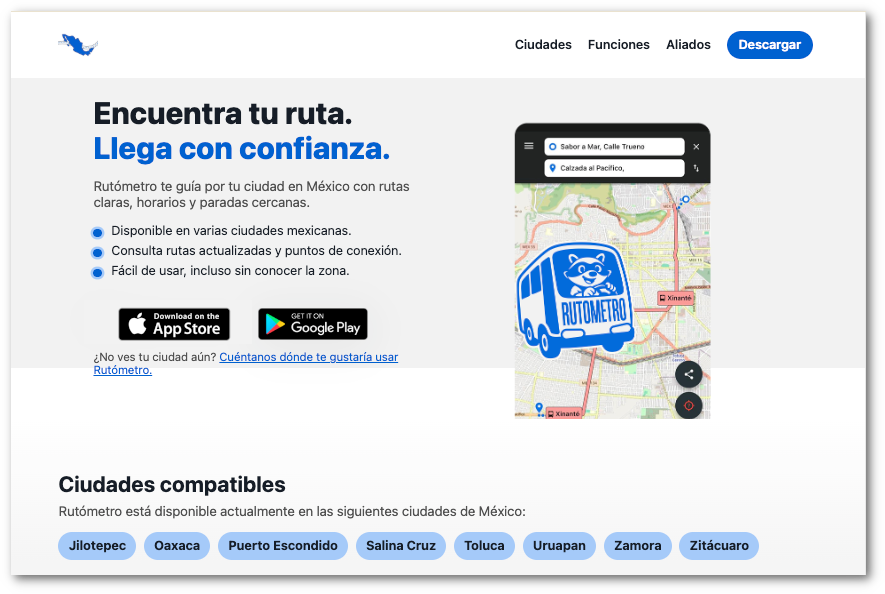In the global South where Trufi does the majority of our work, public transport data is often missing or inaccessible. This is especially true in cities where informal networks fill the gaps left by formal systems. In Mexico, a country with some of the highest transportation emissions and the least public transport data, a new Trufi collaboration is changing that.
Our partners in the project are Codeando México and Humanitarian OpenStreetMap Team (HOT). Combining our strengths, we are making public transport visible, usable, and community-driven. By mapping routes, stops, and schedules in OpenStreetMap (OSM) and converting that data into an open standard for transport data (GTFS), we create the missing data cities need to plan better transport services, reduce emissions, and give better mobility options to people who depend on it.
This video from HOT (in Spanish) is an overview of the project. Below the video are the highlights and Trufi context in English.

Open Data Connects People to the Places They Need To Go
“Mexico is one of the ten countries with the highest carbon emissions from transportation and is one of the countries with the least information on public transport,” says Alma Rangel, Executive Director of Codeando México.
The project brought together civil society, government, transporters, and concessionaires to collect and publish transport data for citizens.
But it’s about more than mapping routes. “People won’t look for where Route 4 travels; they will look for how to get to the General Hospital, and they will get to the General Hospital via Route 4,” said Céline Jacquin, Regional Senior Manager at HOT. “When we map transportation, many aspects of the city itself are important in that mapping because that is what people will be looking for.
Trufi’s First Multi-City App
The process starts with assessing existing data, then training governments and volunteers in collaborative mapping. “We support municipalities to review, verify, and clean the data,” says Óscar Hernández, Project Coordinator at Codeando México, “making it ready for use in the next stages of the project.”
Trufi Association contributed OSM mapping expertise and the methodology to convert OSM data into GTFS, ensuring the data is usable for apps, planners, and researchers.
“The main contribution is that we created GTFS in Mexico and created journey planning applications in the cities,” says Leonardo Gutierrez, Trufi’s Business Development Manager. “The cities are Jilotepec, Oaxaca, Puerto Escondido, Salina Cruz, Toluca, Uruapan, Zamora, and Zitácuaro.”
In Toluca alone we processed more than 600 routes. That’s “a lot of work,” Gutierrez said. “We processed all the data received from the government, generated the GTFS, and implemented the journey planner application.” This work led to Rutometro, Trufi’s first multi-city app in any country, making trip planning accessible across regions.
Volunteers don’t just collect data, they maintain it. “Volunteers today collect the data for this project, but they also have the capacity to continue with its updating and maintenance later on,” Rangel adds. This keeps the data sustainable, adapting as cities grow and change.
Safety, Gender Equity, and Mobility
Public transport is about mobility, access, safety, and equity. “The issue of safety in public spaces in general for women is key.” says Jacquin highlighting the gender dimension. “It is essential to address the issue of transportation and how women wait in public spaces for the bus, for their transport, with a focus on gender and personal safety.”
When governments have digitized transport data, they can identify gaps in coverage and service. “Having this data allows governments to analyze and improve the service,” Hernández notes. In cities where private transport dominates due to unreliable public options, open data can help shift the balance.
Join and Support the Movement
“We invite you to share experiences with other municipalities and cities and to reach out to the groups within your cities, universities, and civil society organizations that are willing to help in this process,” says Rangel.
Public transport data is a necessity. By making it open, collaborative, and actionable, we can build cities where mobility is accessible, safe, and sustainable for everyone.
You can also Sponsor Trufi Association as an individual or company

